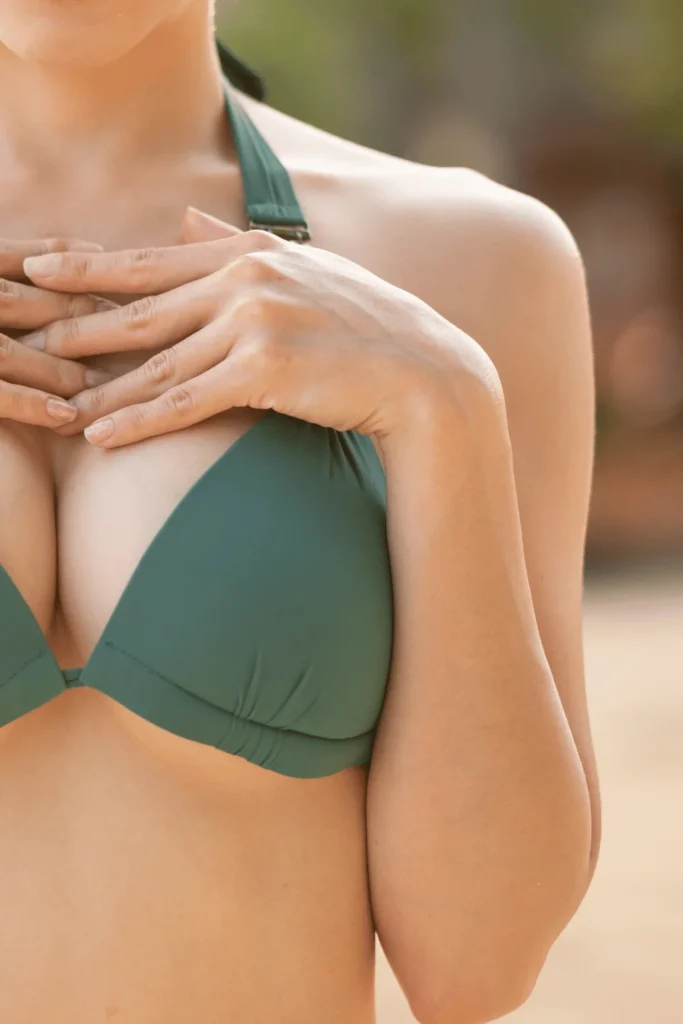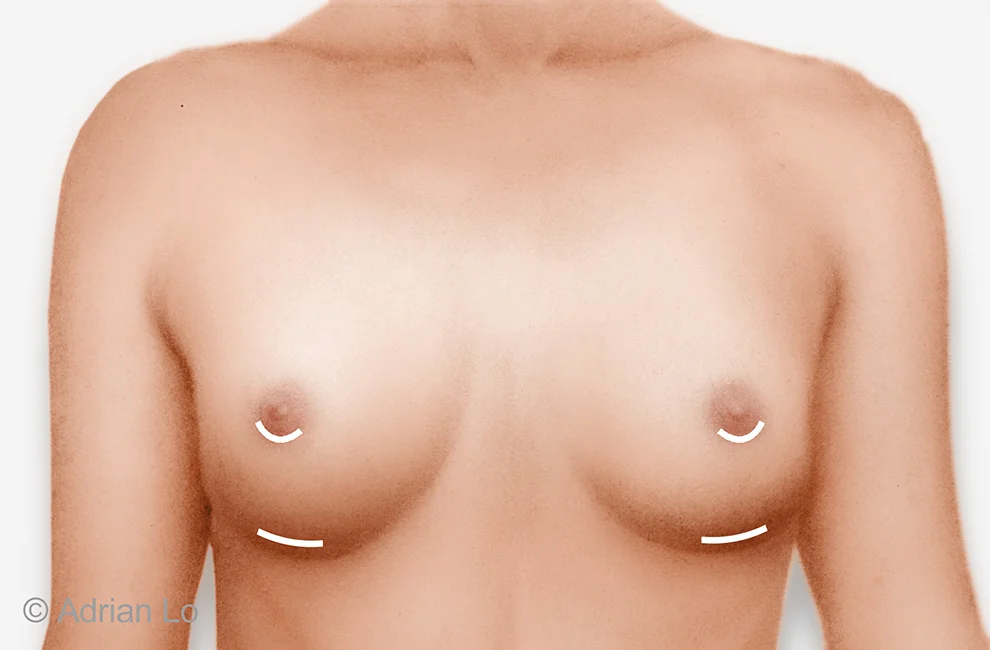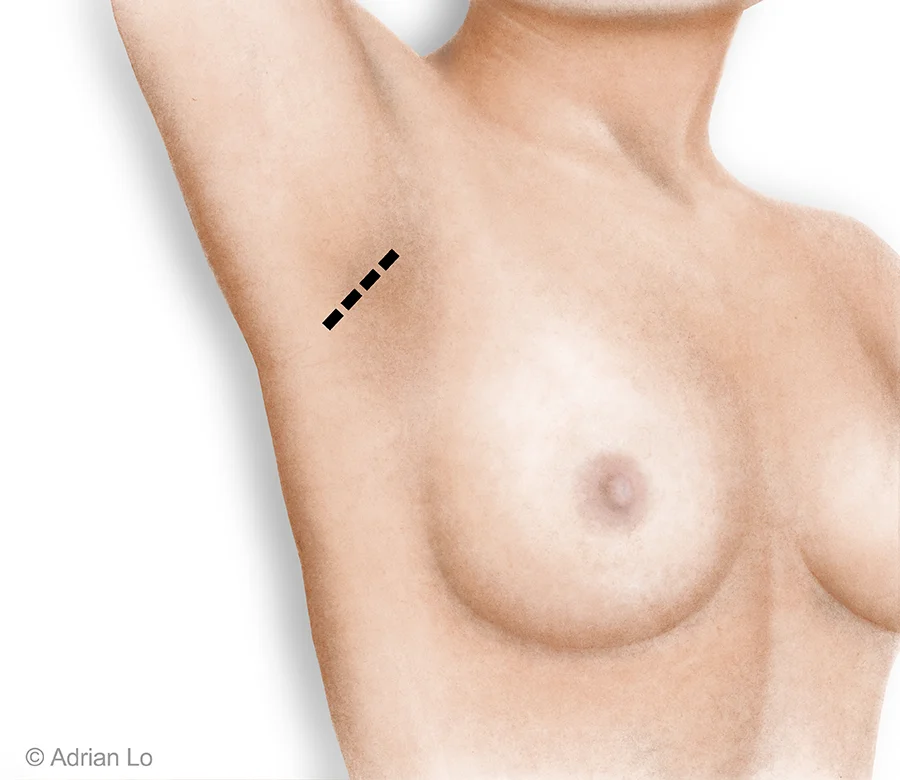If you’re considering breast augmentation, it’s natural to have questions about boob job scars.
Understanding the potential for a boob job scar is an essential part of preparing for breast augmentation surgery. A common question patients ask is “do boob jobs leave scars?” and the answer is yes, however, modern techniques aim to minimize their visibility.
When it comes to breast augmentation, the goal is to enhance your appearance while keeping any signs of surgery as discreet as possible. While a boob job does leave scars, today’s advanced surgical methods allow for smaller incisions and strategic placement to reduce their visibility.
However, it’s important to have realistic expectations and understand that some scarring is inevitable.
Want to take a look at real results? Take a look at Dr. Lo’s breast augmentation before-and-after photos!
Understanding Breast Augmentation: Boob Job Scars

When it comes to breast augmentation, there’s no one-size-fits-all approach. Different types of incisions are used, each with its own set of pros and cons. The choice of incision can significantly affect the location and appearance of your boob job scars.
Your plastic surgeon will recommend the best option based on various factors, including your body type, the size and type of implants you’re getting, and your personal preferences. It’s crucial to discuss these options thoroughly with your plastic surgeon during your consultation.
The skill and experience of your plastic surgeon play a vital role in minimizing scarring. That’s why it’s essential to choose a board-certified plastic surgeon with a proven track record in breast augmentation procedures. They will have the expertise to not only perform the surgery but also to place incisions in a way that promotes optimal healing and minimal scarring.
Now, let’s explore the four main types of incisions used in breast augmentation:
1. Inframammary Fold Incision
The inframammary fold incision is one of the most common approaches in breast augmentation. This incision is made along the natural crease beneath your breast, where it meets your chest wall. The scar typically measures about 1-2 inches in length and is hidden in the shadow of your breast.
One of the main advantages of this incision type is its versatility. It provides excellent access for implant placement. This approach works well with all types of implants, including silicone and saline, and is suitable for various implant sizes.
The healing process for scars from a boob job, particularly with an inframammary fold incision, is generally straightforward. As boob job scars heal, they typically transition from red and slightly raised to a thin, pale line over time that’s easily concealed by the natural fold of the breast, bra or swimsuit.

2. Periareolar Incision
The periareolar incision is another popular choice in breast augmentation. This incision is made around the lower half of the areola, the pigmented area surrounding your nipple. The scar from this incision tends to blend well with the natural transition between the areola and the surrounding breast skin.
One of the key benefits of the periareolar incision is its ability to camouflage the scar. The natural color difference between the areola and breast skin helps to disguise the incision line. Additionally, this approach can be used for future surgeries if needed.
However, there are some considerations to keep in mind. This incision type may not be suitable for women with very small areolas or those opting for significantly large implants. There’s also a slightly higher risk of changes in nipple sensation or difficulties with breastfeeding compared to other incision types.
3. Transaxillary Incision
For those concerned about visible scars on the breast itself, the transaxillary incision offers an intriguing alternative. This approach involves making a small incision in the natural fold of the armpit. The implant is then carefully placed into position using specialized instruments.

The main advantage of the transaxillary incision is that it leaves no scar on the breast itself. The resulting scar in the armpit is typically small and well-hidden in the natural folds of the skin. This can be particularly appealing for women who are prone to keloid scarring or those who prefer to avoid any marks on their breasts.
However, this technique does come with some limitations. It’s generally more difficult to perform for an inexperienced plastic surgeon. With an experienced plastic surgeon like Dr. Lo who specializes in the transaxillary approach, both silicone and saline implants may be placed with excellent cosmetic results. Additionally, for the inexperienced plastic surgeon, this approach may make it slightly more difficult to achieve perfect symmetry or to perform revision surgeries if needed in the future.
4. Transumbilical Incision
While a complete “boob job no scars” procedure doesn’t exist, the transumbilical incision (TUBA) is another approach that leaves no visible scars on the breasts.
This technique involves making a small incision inside the navel, through which the implants are inserted and moved up to the breast area.
The primary benefit of this approach is that it leaves no scar on or near the breasts. The incision in the navel typically heals very well and is virtually undetectable. For women who are particularly concerned about scarring, this can be an attractive option.
However, the transumbilical incision comes with significant limitations. It can only be used with saline implants, as these can be inserted empty and filled once in place. Silicone implants, which come pre-filled, cannot be used with this technique. Additionally, this approach provides less direct access to the breast pocket, which can make it more challenging to achieve precise implant placement.
Due to these limitations and the specialized skills required, the transumbilical incision is not widely offered and is performed by relatively few plastic surgeons. It’s important to thoroughly discuss the pros and cons of this approach with your plastic surgeon if you’re considering it.
Factors Affecting Scar Appearance
When it comes to boob job scars, it’s important to understand that their appearance can vary significantly from person to person. Several factors interact to influence the final appearance of your scars.
Your body’s natural healing process plays a crucial role. Some people are simply predisposed to healing with less noticeable scars, while others may be more prone to prominent scarring. Factors such as age, genetics, overall health, and lifestyle habits can all impact how your body heals.
It’s also worth noting that most scars fade significantly over time. What may initially appear as a noticeable red line typically softens and fades over the course of several months to a year. With proper care and patience, many women find that their scars become barely noticeable.
Let’s delve into some specific factors that can affect scar appearance:
Surgical Technique
The skill and experience of your plastic surgeon play a pivotal role in minimizing scarring. A skilled plastic surgeon will use techniques to create the smallest possible incision while still allowing for proper implant placement. They’ll also pay careful attention to closing the incision in a way that promotes optimal healing.
Precise incision placement is crucial. Even a slight variation in placement can affect how well the scar heals and how visible it is. For example, with an inframammary incision, placing it exactly in the breast crease helps to keep it hidden in the natural shadow of the breast.
Advanced suturing methods can also make a significant difference. Many plastic surgeons use layered closure techniques, which involve closing the deeper layers of tissue before addressing the skin surface. This approach helps to reduce tension on the wound, which can lead to better healing and less noticeable scarring.
Skin Type and Genetics
People with fair skin often have scars that start out pink or red and then fade to white over time. Those with darker skin tones may develop darker scars initially, which then gradually lighten.
Some individuals are genetically predisposed to developing keloid or hypertrophic scars. These are raised, thickened scars that extend beyond the original incision site. If you have a history of this type of scarring, it’s crucial to discuss this with your plastic surgeon before your procedure.
Certain skin conditions or health issues can also affect scar formation. For example, people with conditions that affect collagen production or wound healing may be at higher risk for more noticeable scarring.
Your plastic surgeon will take these factors into account when planning your treatment. They may recommend specific pre-operative treatments or post-operative treatments to optimize healing if you’re at higher risk for prominent scarring.
Post-Operative Care
The care you provide to your incisions after surgery can significantly impact your final scar appearance. Following your plastic surgeon’s post-operative instructions to the letter is crucial for optimal healing.
Specific care techniques can promote better healing. These may include keeping the incision sites clean and dry, avoiding excessive movement or stretching of the chest area during the initial healing period, and wearing a supportive surgical bra.
Many plastic surgeons recommend the use of silicone sheets or gels once the incisions have fully closed. These products have been shown to help improve scar appearance by keeping the area hydrated and reducing collagen buildup.
Sun protection is also vital for healing scars. UV exposure can cause scars to darken and become more noticeable. It’s important to keep your scars protected from the sun, either by covering them or using a high-SPF sunscreen, for at least a year after your surgery.
Plan Your Breast Implant Surgery with Dr. Adrian Lo!

Ready to take the next step towards your breast augmentation journey and minimize boob job scars? Contact Dr. Adrian Lo‘s Philadelphia and Marlton NJ plastic surgery office today to schedule your consultation.
Let’s work together to achieve the beautiful, natural-looking results you desire, with minimal scarring and maximum satisfaction!
